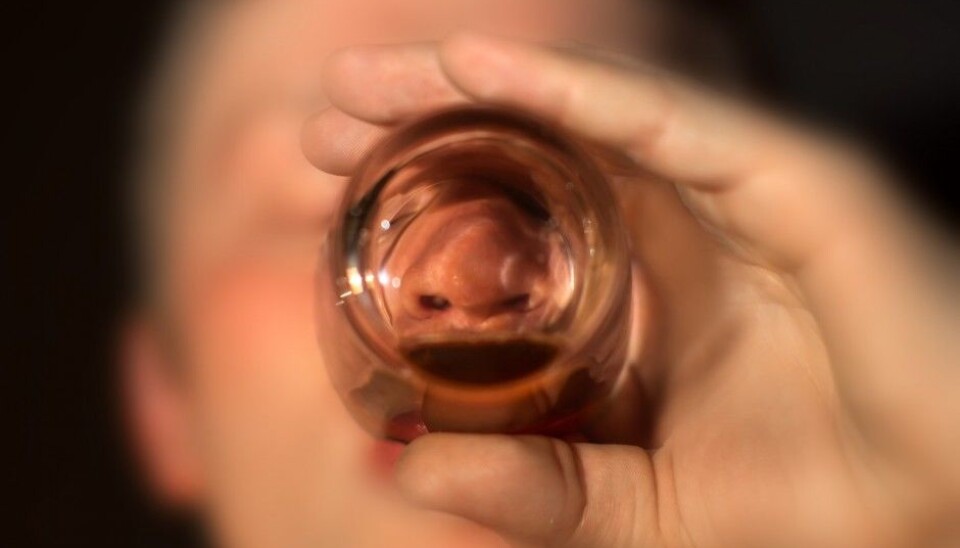
This is what drinking does to the brain
Finnish researchers were surprised to find more changes in men’s brains than in women’s.
The brain’s billions of neurons are always active in any living person. They are interlinked in a network that sends electrical pulses to one another. This happens in everything we do – if we are thinking, running, smiling, remembering, sensing or simply scratching an arm.
Chemical compounds transfer a signal from one neuron to the next.
When Finnish scientists studied the brain activity of 27 young men and women who had been drinking rather regularly for ten years, they found that parts of this activity differed from the norm.
The scientists thought the long-term alcohol intake would impact the women most. So they were very surprised to find the opposite. The researchers recently presented their results at a meeting of the European College of Neuropsychopharmacology (ECNP).
“This means that male brain electrical functioning is changed more than female brains by long-term alcohol use,” said Outi Kaarre in a press release from ECNP. She is one of the researchers who conducted the study and works at the University of Eastern Finland and Kuopi University Hospital.
Women and men react differently
The brains of the young Finns were examined by a stimulation of their neurons with magnetic impulses from the outside of their skulls – a procedure called transcranial magnetic stimulation, or TMS. This is known to activate brain neurons. The researchers used an electroencephalogram (EEG) to measure the brain activity responses.
A greater electrical response in the cortex of the brain captured by an EEG can indicate a change has occurred and this is found in heavy alcohol users.
The Finns repeated the experiment with another group of young men and women. These served as a control group as they had drunk little or no alcohol in the same ten-year period from adolescence.
The Finns in the study were aged 23 to 28, meaning that the first group had drunk alcohol since they were 13 to 18. It is not unusual to start drinking at such tender ages. In 2015, a study by the National Development Center for Children and Young Adults in Oslo found that one in ten Norwegian 12-year-old boys had drunk alcohol at least once in the past month and three percent had drunk enough to get intoxicated.
That study showed that more boys than girls in 7th grade had used alcohol and more boys than girls got drunk – meaning they had imbibed at least five units at one time. The study seems to show that regarding early starts in drinking one risk factor is simply being a boy.
It’s nothing new that men and women react disparately to alcohol.
“This has been suggested before but our study indicates a possible mechanism for these differences,” says Outi Kaarre.
The researchers do not say exactly how much the young people in the study had been drinking or how much alcohol had affected their everyday lives, but those tested did not have problems that were serious enough to be called alcoholism. They were considered normal alcohol users. Even though they were not alcoholics their drinking had clearly affected their brains, according to the Finnish study.
Change in transmitting of signals
The researchers found that a flow of a particular chemical compound which moves from one neuron to the other called GABA can be changed after ten years of drinking.
Neurons are equipped with molecules that receive information – receptors. These catch the electrochemical impulses sent to them by other neurons.
In the study of the young Finns the researchers found changes in one type of receptor called GABA-A among the women. Among the men they found two types of receptors had changed after the ten years of drinking, both GABA-A and GABA-B.
For both sexes this means the flow of GABA is affected, but more among men than women because they had changes in two of the GABA receptors in their brain neurons.
The medical scientists do not know what this means for us, but experiments on animals have already shown that there is something about the transfer of GABA between neurons that can be linked to use of alcohol.
“We know that GABA receptors seem to impact drinking patterns, while GABA-B receptors appear to affect the general desire to drink alcohol,” says Kaarre.
GABA is involved in many neurological systems and it is linked to anxiety and depression. The Finnish researcher says it “generally seems to calm down brain activity.”
Consequences for treatment
In the Finnish study the researchers have not compared the brain activity of the same individuals before and after ten years of drinking. If they had they could conclude a transformation has occurred.
Wim van den Brink, a professor of psychiatry and addiction at the University of Amsterdam, pointed this out in a press release from the European College of Neuropsychopharmacology.
Van den Brink, who was not involved in the study, finds it intriguing: “Especially since young women are catching up with young men when it comes to drinking and heavy drinking in Europe.”
Both Kaarre and Van den Brink think the results should be considered with regard to the treatment given to men and women who are burdened by their abuse of alcohol.
One of the latest medications for alcohol dependence targets the GABA-B receptors, which have only been altered among men in the study.
“It has shown mixed results, which may be explained by this work,” says the professor.
-------------------------------------
Read the Norwegian version of this article at forskning.no
Translated by: Glenn Ostling






